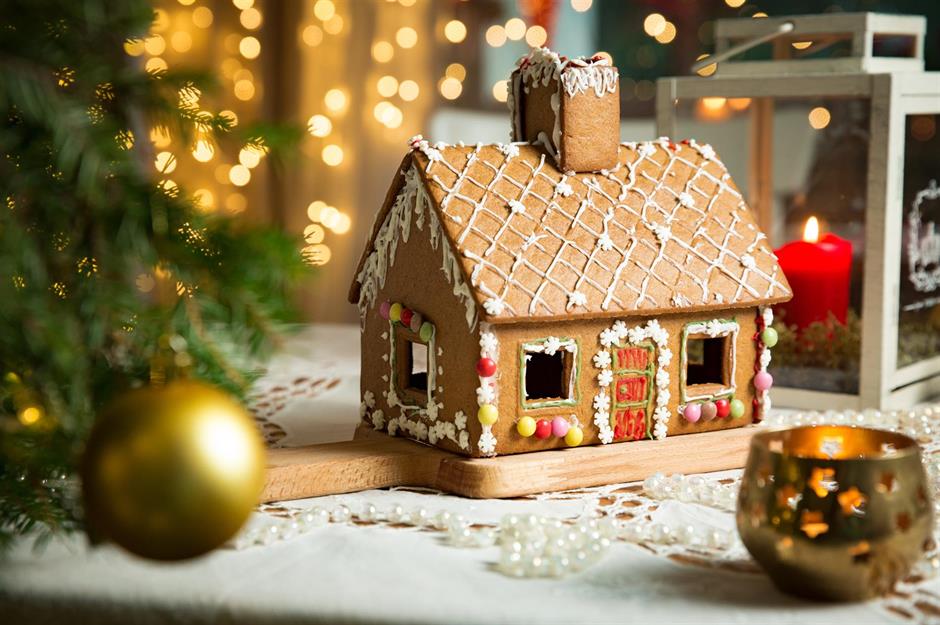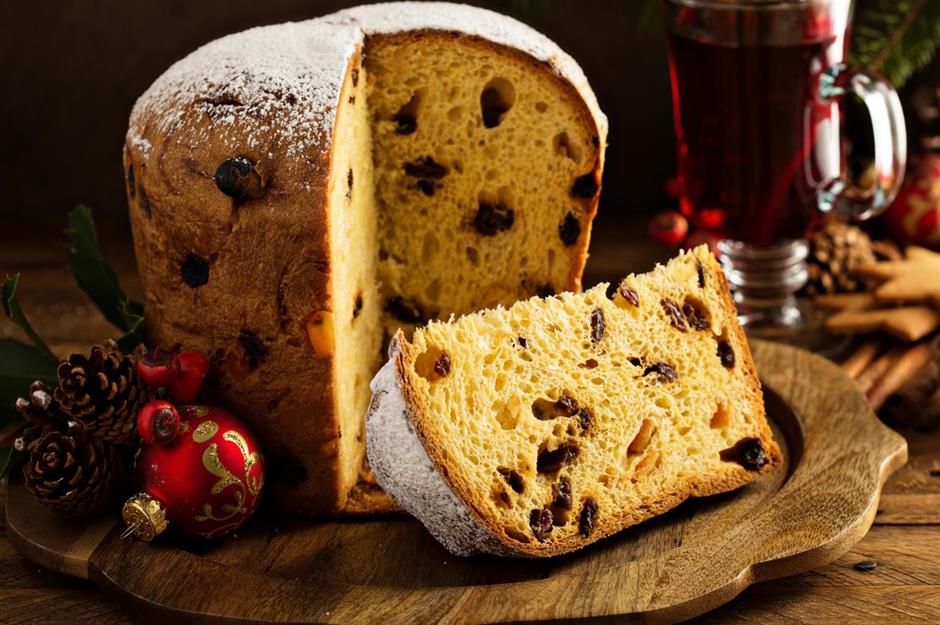The curious history of Christmas foods – and why we eat them
Christmas culinary mysteries
Why do Italians eat panettone?
It's believed that panettone in some form has been baked since the 13th century, but there are many stories around how it rose to popularity. One such legend is that during a Christmas banquet held by the Duke of Milan in the 15th century, the dessert was burnt. Luckily, a young cook called Toni came to the rescue and created a rich brioche bread filled with raisins and candied fruit. The Duke loved it, and it quickly became a beloved national festive bake.
Why do we eat candy canes?
According to folklore, the iconic peppermint-flavoured boiled sweets date back to 1670, when a German choirmaster asked a local confectioner to make them to keep his young singers quiet during services. It's likely that the candy made its way to America with European immigrants. It's here where the sweet gained its red stripes, added by a candy maker in Albany, Georgia, around 1920.
Why don't mince pies contain meat?
Mince pies did used to contain meat, often mutton or beef, which was mixed with dried fruits, spices and suet. The pies were mostly the preserve of the wealthy, served on special occasions because ingredients like spices were expensive. Towards the end of the 19th century, pies without meat became more popular as sugar became easier to get hold of, and the version we know and love today came into existence.
Why do we put oranges in our stockings?
When fresh citrus fruit was not readily available, an orange at Christmas was considered a luxury. The tradition of placing oranges in Christmas stockings also references an old Christmas tale in which St Nicholas gave three gold balls to a father who couldn't afford his daughters' dowries. The balls were tossed down the chimney and fell into stockings hanging by the fire.
Why do we drink eggnog?
Eggnog, a classic creamy drink that many enjoy around Christmas, has its roots in 13th-century Britain, where medieval monks drank posset – a warm, milky ale punch made with figs and eggs. Fast-forward several centuries, and a new version of the drink – spiked with sherry, Madeira or brandy – had become popular with the upper classes. When it crossed over to the US during the 18th century, rum, which was plentiful, was used. Before refrigeration, the booze also prevented the drink from spoiling.
Why is turkey traditional?
Turkey arrived in England in the 16th century, and Henry VIII was purportedly the first monarch to serve the bird as part of a Christmas feast. Over the decades, it gained popularity around the festive season, but it wasn't actually until around the 1950s that turkey was cemented as a Christmas Day centrepiece in the UK and America. Better affordability and the advent of refrigeration contributed to making it a holiday staple.
Why do we eat roasted ham?
Also known as a yule ham, this sumptuous roast supposedly originated from ancient Norse pagans paying tribute to the god Freyr – the god of fertility, harvest and boars. When pagans converted to Christianity, ham became linked with St Stephen's feast day, which falls on 26 December.
Why is goose eaten at Christmas?
Goose has been eaten around the end of the calendar year for thousands of years: in ancient Greek rituals, to ensure a good crop the following spring; during Michaelmas, a winter solstice feast in the Middle Ages; and at British Tudor banquets. And of course, it was the centrepiece bird for the Cratchit family in Dickens' A Christmas Carol. Goose is also extremely seasonal as it naturally reaches full maturity towards the end of the year.
Why do we eat and gift cookies at Christmas?
This sweet treat goes all the way back to the Middle Ages, when spices such as nutmeg, cinnamon and black pepper became more available in the West. By the 16th century, cookies had become popular across Europe, and it's thought that they made their way to America via Dutch immigrants in the early 17th century. Nowadays, they're a staple sugary snack all year round – and especially at Christmas.
Why do the French feast on bûche de Noël?
Also known as a yule log, a bûche de Noël (as it's called in France) is a log-shaped chocolate cake that evokes an old European pagan tradition of specially selecting a wooden log to burn at what is now Christmastime. The cake dates back to the 19th century, and has remained a popular festive dessert.
Why do we eat Brussels sprouts?
Like a lot of Christmas food traditions, it's not entirely clear why Brussels sprouts became a staple on British Christmas tables. Some suggest that when Brussels sprouts became more readily available in Britain towards the end of the 19th century, it was also when modern Christmas traditions were being created. And so the custom of serving the little brassicas on 25 December stuck – much to many people's dismay today.
Get the recipe for pan-fried Brussels sprouts with bacon here
Why do we eat fruitcake?
The story goes that British Christmas cake, traditionally a dense, rich fruitcake, began as plum porridge. The oatmeal-based dish was eaten on Christmas Eve, and later, other fruits and honey were added to the mix – a version of today's Christmas pudding. Around the 16th century, the oats were removed and spices, flour and eggs were added, starting to resemble the fruitcake we have today. Wealthy families would even wrap it in marzipan, another hallmark of today's cakes.
Why do we drink mulled wine?
This well-loved winter drink was apparently created by the Romans in the 2nd century, to keep them warm during the cold winters. And as their empire spread, so did the hot wine. Throughout the Middle Ages, it grew in popularity as Europeans added herbs and spices to avoid sickness, and the craze only continued apace. It wasn't until the 1890s when the drink became associated with Christmas.
Get our recipe for mulled wine hot chocolate – a twist on the classic – here
Why do we put stuffing in turkey?
It's likely that people began stuffing meats as early as they began cooking food, but the first written record was in a Roman cookbook called Apicius De Re Coquinaria. The stuffing consisted of vegetables, spices, nuts, herbs, spelt and offal. By 1836, stuffing became a staple around the holiday season.
Why hide pickles in the Christmas tree?
On Christmas Eve, many families hide a pickle ornament in the Christmas tree. The next morning, the child who finds the pickle receives an extra gift or the privilege of opening the first present. But no one really knows how this tradition came to be. Some say it originated in Germany, and others believe it's in honour of a Civil War soldier who was saved from starvation on Christmas Eve by eating a pickle. But the most likely (and not-so-romantic) story is that the tradition was made up by salesmen to sell more German glass ornaments in the late 19th century.
Why do we hide a sixpence in Christmas puddings?
The British tradition of hiding a coin in a Christmas pudding (now more likely to be a 5p coin as the traditional sixpence no longer exists) most probably dates back to Roman winter solstice rituals. During Saturnalia, a bean was hidden in a galette, and whoever found it was king or queen for the day. Then in medieval times, a bean was hidden in a cake and eaten on Twelfth Night (or Epiphany, which is still celebrated today in France). It eventually morphed into a coin in modern-day homemade puddings, supposedly bringing good luck for the following year to whoever finds it in their slice.
Why do we have edible advent calendars?
Advent was originally the period for converts to Christianity to prepare for baptism, but it's now more commonly associated with the countdown to Christmas Day. The tradition of marking the weeks in December dates back to the mid-19th century, but people would light candles or make chalk marks rather than enjoy a small chocolate. The first printed cardboard calendar with doors didn't come about until the early 20th century in Germany, and the first chocolate calendar appeared in 1958. Nowadays, you can find a whole host of advent calendars filled with everything from gin and tea to sweets and cheese.
What's the story behind chocolate coins?
Chocolate coins are a firm favourite at Christmastime, and there are various stories about the tradition. Some say they represent the gold gifted to baby Jesus by the Three Wise Men in the nativity story. Others believe it's inspired by St Nicholas secretly gifting coins to children or giving gold to a father who couldn't afford his daughters' dowries – it's why in some countries, little gifts are given on St Nicholas' Day on 6 December. Chocolate coins, or gelt, are also given during Hannukah, and are said to represent the tips given to teachers, butchers and other employees at this time of year.
Why do Italian-Americans celebrate the Feast of the Seven Fishes?
Many Italian-American families celebrate La Vigilia di Natale, or Feast of the Seven Fishes, on Christmas Eve, where they eat an extensive seafood feast before midnight mass. This tradition dates back to the Roman Catholic custom of abstaining from meat and dairy products on the eve of important holidays. The seven courses of fish most likely refer to multiple Catholic symbols around the number seven, such as the seven sacraments, seven days of the creation story and the seven deadly sins.
Why do we set our Christmas puddings on fire?
Setting the Christmas pudding on fire burns off excess brandy and provides some great culinary theatre on Christmas Day – but many say there's more to this dessert tradition. Some believe it's a nod to pagan winter festivals involving fire, and others believe it represents the Passion of Christ. Either way, there's no better way to round off Christmas lunch.
Take a look at these favourite foods that were invented by accident
Why do people in Japan eat KFC at Christmas?
An estimated 3.6 million Japanese families tuck into KFC at Christmas. Why? Christmas isn't an official holiday in Japan, where around 1% of the population is Christian, but in the 1970s, the fast food chain ran a highly successful marketing campaign for a holiday fried chicken bucket. Ever since, it's been a must-have for families – and apparently 40% of orders are made up to two months in advance.
Why do we make gingerbread houses?
Gingerbread, in some form, had been made long before it was fashioned into houses. The biscuit-walled and candy stained glass-windowed houses are said to have originated in Germany during the 16th century, and were popularised by the Grimm brothers' fairy tale Hansel and Gretel.

